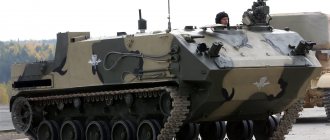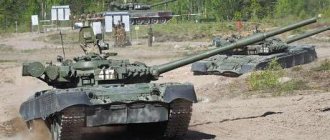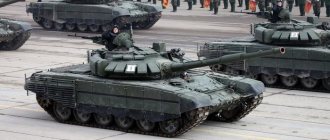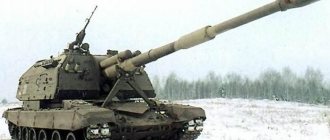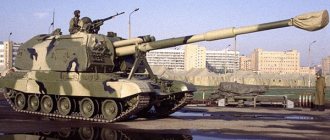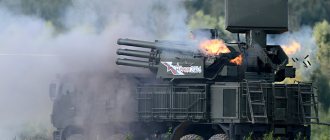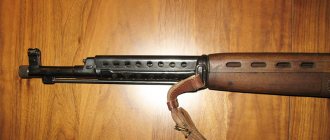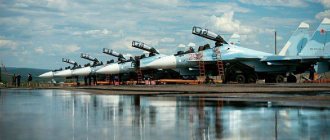During the existence of the USSR, cars for the representative class were produced by the Likhachev plant. During the reign of Stalin, these were heavy and armored ZiS limousines.
In Khrushchev's times, a lighter ZIL-111 limousine was used, made in an “aerospace” design. Then, during the time of Brezhnev, a new ZIL-114 limousine, which had no analogues in the USA, was used. The completion of this line of cars was the hero of this article - the last limousine ZIL-4104, which replaced the previous cars in 1978.
And Brezhnev is driving them
Leonid Ilyich was a passionate motorist and loved to drive himself. Which did not please his guards at all. As a passenger, the Secretary General most often rode in the front seat, next to the driver. The whole country saw this in television reports.
Leonid Brezhnev loved to ride next to the driver.
Leonid Brezhnev loved to ride next to the driver.
Description of the design of the ZIL-4104 limousine
The car had a limousine-type body; a special soundproof partition divided its seven-seater interior into two completely independent parts. One of the rows of seats reclined towards the dividing partition, which made it possible to significantly increase the free space for passengers.
The car's interior was equipped with all types of multimedia equipment existing at that time: there was an all-wave radio receiver and a tape recorder, and six speakers were installed around the perimeter. Each part of the cabin had its own heating and air conditioning system. The car had triplex glass with electric windows. The interior of each car was made individually, in accordance with the wishes of the customer.
Absolutely all parts of the ZIL-4104 body were made and adjusted by hand, the body was then covered with 10-15 layers of paint, each of them dried and polished.
The car was equipped with a petrol V-shaped engine with eight cylinders. Its power was 315 hp. With.
The ZIL-4104 automatic transmission has a three-speed gearbox and torque converter.
The front suspension of the car is independent with torsion bars as elastic elements. The rear is dependent with traditional springs. The car was equipped with ventilated disc brakes on all wheels.
The last trips of the leaders
And then came an era when general secretaries began to change more often than government cars. In the fall of 1982, Leonid Brezhnev died, and Yuri Andropov took his place. In 1983, production of the modernized ZIL-41045 began. It differed from the 4104 model in small details - lighting equipment, bumpers, chrome on the massive radiator grille.
Secretary General Konstantin Chernenko near the ZIL-41045 limousine.
Secretary General Konstantin Chernenko near the ZIL-41045 limousine.
Your browser does not support the audio element.
ZIL-4104(115)
ZIL-4104 is a luxury car with a limousine body, produced by the plant named after. Likhachev in 1978-1983. Experimental cars and cars of the first production were designated ZIL-115 [1], which was later replaced by ZIL-4104 due to the adoption of a new classification system in the USSR. In 1983-1985, the ZIL-41045 car was produced, and in 1986-2002 - ZIL-41047. They had only some external differences from the base model; technically, all models in the series were the same. The interior was created taking into account the intended use of cars - for high-ranking government officials. Acceptance tests of the ZIL-115 (this was the factory index of the car) were carried out in January 1978, and in early October the first batch of cars, designated ZIL-4104, was assembled. ZIL-4104 became the last car used by the General Secretary of the CPSU Central Committee L. I. Brezhnev. In total, from 1978 to 1983, 106 ZIL-4104 cars were built in various modifications. In 1981, the ceremonial phaeton ZIL-41044 (ZIL-115V) was created with an automatically folding top (lowering and raising time - no more than 20 s) and automatically folding side frames glass The car was equipped with a microphone unit, a radio station and antennas on the rear wings. A total of three such cars were produced. Until 2009, they took part in military parades on Red Square: two vehicles were intended for the Minister of Defense and the parade commander, the third was a reserve vehicle, and was on duty at the Spassky Gate during the parade in case of unforeseen situations. Currently, they are all operational and are on the balance sheet of the Russian Ministry of Defense. The armored version of the car had three modifications. The design of these cars was based on the so-called armored capsule - a load-bearing volume of a complex configuration. The rest of the body was built around it. The armored capsules of the cars were identical and were welded at the Kurgan plant. A total of 25 armored capsules were manufactured, two of which were intended for fire tests (ZIL-4105). The thickness of the armor is from 4 to 10 mm, the thickness of bulletproof glass: windshield - 43 mm, side and rear - 47 mm. Multilayer fire-explosion-proof fuel tanks, self-tightening during breakdown, were developed and produced in the pilot production of the Steel Research Institute. The curb weight of the vehicle, depending on the purpose of the armored car and the availability of equipment, ranged from 5160-5225 kg. The car was equipped with two high-power interior heaters and air conditioning. A total of 14 such vehicles were built, and for six of them armored capsules from used vehicles were used. It is very difficult to track when ZIL limousines stopped being produced. After the collapse of the USSR, the Russian government quickly switched to foreign cars, but ZILs remained in the garage and are sometimes used. The plant continues to service these cars and states that it is ready to fulfill orders (including private ones) for their production at any time. However, whether such customers exist remains a mystery.
Replacing a carburetor as a special operation
Life began to change rapidly, which even affected the quality of Soviet government limousines. In the mid-1980s, during Gorbachev’s official visit to France, GON employees changed a huge four-chamber K-259 carburetor right in the courtyard of the Elysee Palace in Paris in a few minutes. There was no way out: gasoline dissolved in the device... one of the gaskets!
Mikhail Gorbachev's motorcade in Norilsk, 1988
Mikhail Gorbachev's motorcade in Norilsk, 1988
The repairs took place under the cover (literally) of security officers, who did everything to ensure that the “operation” was seen by as few people as possible.
Design and technical characteristics of ZIL-4104
Specifications:
- Capacity - 7 people;
- Length - 6.3 meters;
- Width - 2.1 meters;
- Height - 1.5 meters;
- Wheelbase - 3.88 meters;
- Ground clearance - 17 centimeters;
- Weight - 3.9 tons;
- Engine - carburetor;
- The volume of the power unit is 7.7 liters;
- The power of the power plant is 315 horsepower at 4-4.6 thousand rpm;
- Transmission - automatic;
- Maximum speed - 190 km/h;
- Acceleration to 100 km/h - 13 seconds;
- Average fuel consumption - 22 liters per 100 km;
- Tank volume - 120 liters.
The closed all-metal body is equipped with four doors. Designed to carry seven people. The back and front rows are separated from each other by a wall with a glass partition. The middle seats can be reclined. Comfortable conditions are achieved through air conditioning, heating, and ventilation systems. An additional element is an all-wave stereo radio, as well as electric windows. To participate in parades and holidays, we developed an open-type modification (41044).
Engine
The power plant is powered by gasoline and is equipped with eight cylinders arranged in a V-shape. At 4-4.6 thousand rpm, maximum power of 315 horsepower is achieved. To reduce the weight of the vehicle, the head and cylinder block are made of durable aluminum. Each block has one overhead camshaft, which operates via a double-row roller chain. Each cylinder has two valves with hydraulic clearance compensators.
The ZIL-4104 engine works together with a four-chamber carburetor and two electric fuel pumps. There are two oil radiators. One is powered by the car's cooling system, the other by air cooling. The transistor type is selected for the ignition system.
Automatic transmission
The automatic transmission is equipped with a torque converter and has three gears. To change gears, use the selector switch located between the front seats. The gearbox design has a mechanical stopper that allows you to hold the car on a descent.
Deactivates automatically when you start moving. The two cardan shafts are separated by an intermediate support. The rear axle is a continuous stamped-welded beam. The main gear of the hypoid type has a gear ratio of 3.62 or 3.31. To install the wheel hub, tapered roller bearings are used.
Suspension
The welded frame consists of stamped side members and cross members. Independent front suspension of the pinless type is mounted on wishbones. Softness and smoothness of movement are achieved due to elastic torsion bars, which are placed along the frame. To prevent oscillations and vibration from uneven road surfaces, the device includes telescopic shock absorbers. The rear suspension is represented by longitudinal semi-elliptical leaf springs of long length. The width of one sheet is 7.5 centimeters and the thickness is 8 millimeters. Between the sheets there are polyethylene gaskets, which also reduce vibrations when moving on uneven surfaces. The spring design is supplemented with reaction bars. Welded wheels have a deep rim. C-studs are used to connect to the hubs. Tubeless tires are 9.35-15.
The steering mechanism consists of two main parts:
- Screw with nut on circulating balls;
- Rack with gear sector.
Gear ratio - 17.5. To reduce the driver's effort on the steering wheel when turning, a hydraulic booster has been introduced. It is powered by a vane pump, which is placed on the toe of the engine crankshaft. The steering wheel position is adjusted relative to the driver's position.
Brakes
The braking system is represented by disc mechanisms on all wheels. It is complemented by a hydraulic drive and automatic gap adjustment. The device has an internal cooling system. Consists of two circuits. Each circuit affects all wheels. Each circuit has a vacuum booster, and the master cylinder is also equipped with it. The parking brake is a drum mechanism on the rear wheels. It is activated by pressing the pedal. Once you start driving, the parking brake is automatically released.
Electrical equipment is powered by a 12-volt system. It operates using a generator producing a power of 1.15 kW and two batteries (120 Ah each). To improve road illumination at night or in bad weather conditions, the headlights and fog lights were equipped with halogen lamps.
Appearance
In the 1970s, the global automotive industry began to change the fashion of car design. Thus, the fin style popular in the 1950s was replaced by more angular and strict outlines. Such changes affected not only American and European manufacturers, but also the Soviet ZIL plant.
In 1974, a plasticine model was developed, and in 1977 the car itself was developed. The radiator grille was chosen as the central part of the appearance. This element gives the car elegance, severity, and, well, heaviness. Chrome lining appeared on the wheel arches.
Comparison with analogues
Let's compare the ZIL 4104 with competing limousines used at that time in the USA and Great Britain. Since 1983, US President Ronald Reagan has traveled in a special version of the Cadillac Fleetwood limousine. The Queen of Great Britain at that time traveled in a Rolls-Royce Phantom VI limousine, produced especially for her in 1978.
| ZIL 4104 | Cadillac Fleetwood (1983) | Rolls-Royce Phantom VI (1978) | |
| Engine | V8, 7.7 l., 315 hp | V8, 350-400hp (according to various sources) | V8, 6.2 l., 200-220 hp. (no exact data) |
| Acceleration to 100 km/h | 13 seconds | no data | 13.5 seconds |
| Transmission | Three-speed automatic transmission | Four-speed automatic transmission | Four-speed automatic transmission |
| Length | 6.3 m. | 6.2 m. | 6.7 m. |
As can be seen from the table, in terms of engine power the ZIL-4104 is inferior to the Cadillac, but significantly ahead of the Rolls-Royce. All limousines have automatic transmissions, but their Western counterparts have one step more. In terms of dimensions, the leader is the Rolls-Royce, which was greatly expanded for the queen’s comfort.
Chassis
The car had a classic frame design. The front used independent suspension with coil springs. At the rear there was a bridge with longitudinal springs and unloaded axle shafts. A similar scheme was usually used on trucks.
There was a stabilizer bar on both axles. It should be noted that all suspension parts have been reinforced. They are designed for enormous loads, which were inevitable with such a curb weight.
checkpoint
The transmission for this car was an automatic three-speed planetary-type gearbox with hydraulic control. Since the drive wheels of the ZIL-4104 were rear, torque was transmitted from the engine via a cardan shaft with an intermediate support.
Despite the fact that the installed gearbox has only three gears, the third one was made as long as possible, which made it possible to move at high speed without feeling discomfort.
